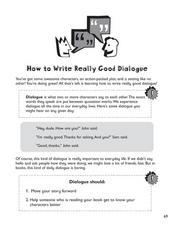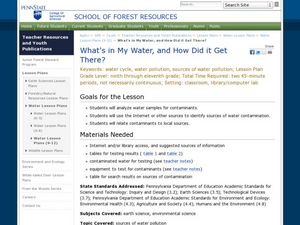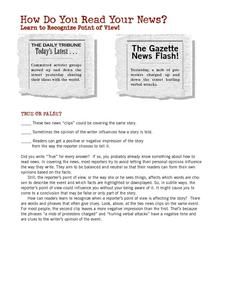Constitutional Rights Foundation
How the First State Constitutions Helped Build the U.S. Constitution
Did you know that the United States Constitution was adopted after many state constitutions were already in place? Young scholars examine facts about the influence of states through an informative and interesting resource. Groups then...
Curated OER
How to Write Really Good Dialogue
How do you create (and punctuate) really good dialogue so that it moves your story forward and provides strong characterization? Use this literary worksheet loaded with examples, clearly stated directions, and fun exercises. Fifth in a...
Curated OER
What's in My Water, and How Did it Get There?
Students analyze water samples to see the contaminants and then use the Internet to find the sources of the contamination. In this investigative water lesson students analyze water and work together to solve the mystery of contaminants.
The New York Times
Stress Less: Understanding How Your Mind and Body Respond to Anxiety
What could be more relevant to teens and preteens than experiencing stress? Use an article from the New York Times website to practice valuable Common Core skills for informational text reading, and also get a discussion going in your...
TV411
How Do You Read Your News?
Words carry baggage. Class members are asked to consider the weight of words in an exercise that contrasts the word choices in two versions of the same event. Consider following the exercise with an activity in which pairs craft positive...
Read Works
How to Say “I Ruff You”
Who says you need a human to be your valentine on Valentine's Day? Give your dog-loving readers an inspiring perspective on how a sister givdes her brother a valentine from the family dog. They then answer 10 questions thatd involve...
American Museum of Natural History
What Do You Know About Astronomy
Develop an understanding of the universe. Learners answer 10 multiple choice questions about several topics in astronomy. Questions contain information about the age of the universe, gravitational attraction, galaxies, planets and comets...
National First Ladies' Library
How Do Flowers Get Their Names?
Students study Carolus Linnaeus and his classification system of plants. They examine the origin of both both common and scientific names of flowers. They speculate how their favorite flowers came to be named and brainstorm about the...
Curated OER
Getting the Message: What Did You Say?
Students listen to and compare the first sentence of the Gettysburg Address spoken in different languages. They also compare frequency readings for each and discuss how the brain interprets spoken words.
Michigan Technological University
Giant Mirrors
Did you know some retailers use curved mirrors in their fitting rooms to make customers look thinner? Pupils view themselves in convex and concave mirrors to understand the difference. The resource includes big ideas for multiple age...
Biology Corner
Pipe Cleaner Babies
Ever been told you have your father's eyes? How did it happen? Young biologists get a hands-on experience in meiotic gene expression with a fun pairs-based activity. Participants use pipe cleaner chromosomes with trait beads to make...
Curated OER
How do I write a friendly letter?
Teach your class the basic format of a friendly letter. Pupils learn about the heading, greeting, body, closing, and signature. There is a brief quiz at the end to check for understanding. The links for this section work correctly and...
Seussville
A Classic in 236 Words
Get in the reading spirit on Read Across America Day while celebrating Dr. Seuss' birthday with four printable worksheet activities. Included is a word search using story character's names, a quiz to test how many Dr. Seuss titles you've...
Curated OER
What Did You Do After the War, Grandpa?
Students consider how World War II impacted Europe and European soldiers. In this Victory in Europe lesson, students visit selected websites to discover information about the war, its conditions, and the celebration that ensued at the...
Curated OER
How Should You Treat Younger Children
Students recognize how younger children should be treated. In this empathy lesson plan, students listen to the story Julius, Baby of the World and then students will work on art projects with students from a younger grade level.
Film English
London
Give your class a tour of London! Before you get started, pupils can brainstorm what they do and do not know about the city and discuss how they think it may have changed over the years. The provided video shows footage from London in...
Curated OER
Module: Workplace Skills
Get your future professionals working in teams as part of a college and career readiness lesson. Discuss times learners have been on teams. What worked and what didn't? How did they settle disagreements? There is a teamwork handout here...
Indiana University
World Literature: "One Evening in the Rainy Season" Shi Zhecun
Did you know that modern Chinese literature “grew from the psychoanalytical theory of Sigmund Freud”? Designed for a world literature class, seniors are introduced to “One Evening in the Rainy Season,” Shi Zhecun’s stream of...
Curated OER
If You Were a Pioneer on the Oregon Trail
Young scholars examine what it was like to travel west on the Oregon Trail. They develop a list of questions about the trip, explore various websites, and create a story about the experiences of a 19th century family travelling on the...
Perkins School for the Blind
Capture the Treasure
Did you ever play capture the flag? I did, and it was so much fun! Your learners with special needs, physical handicaps, or visual impairments can play a classic and highly engaging game with a few minor adaptations. The best part is,...
Curated OER
"Sounds Like Team Spirit"
Some sports teams consider their fans the "12th man" on the field. What does that mean? Are fans that important to their teams? Does fan support really help teams win? How can you let your team know you are rooting for them? Apparently,...
Curated OER
Are These Made of Metal?
How can you tell if something is made of metal? Use a table of data and a science experiment to determine which items are made of metal. The experiment requires adult supervision, as it instructs third graders to build an electrical...
Big Kid Science
Measuring Shadows Using an Ancient Method
How did ancient peoples determine the height of really tall objects? Young scientists and mathematicians explore the concept of using shadows to measure height in a hands-on experiment. Paired pupils measure shadows, then calculate the...
Curated OER
The Language of Human Rights
Did you know that there are 15.2 million refugees in the world? High schoolers will read "The Universal Declaration of Human Rights" and learn how they can get involved to lower this surprising number. To really encourage involvement,...

























